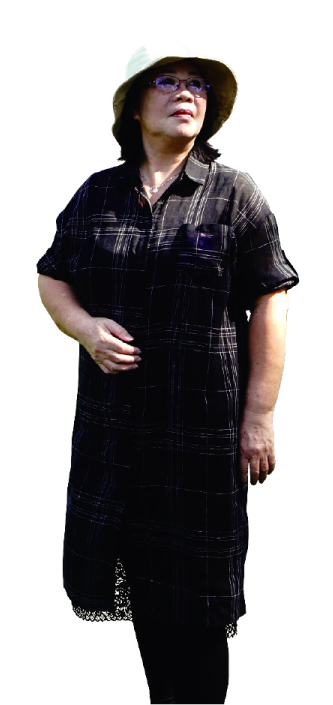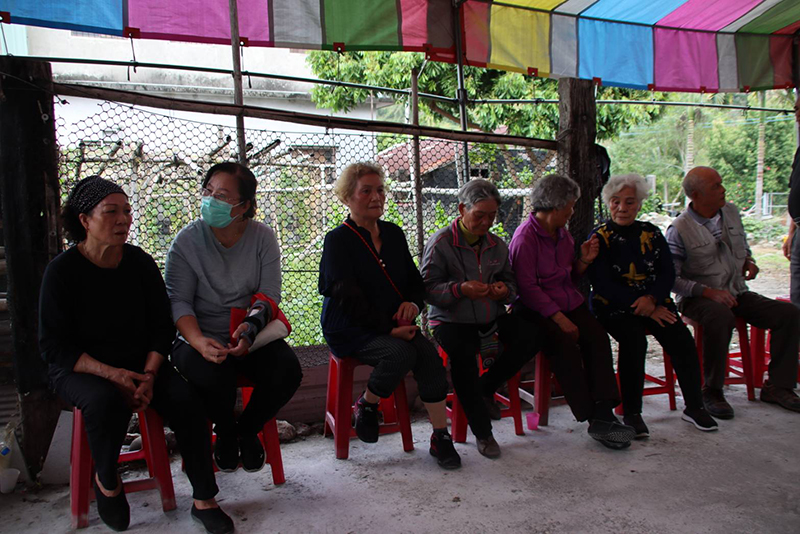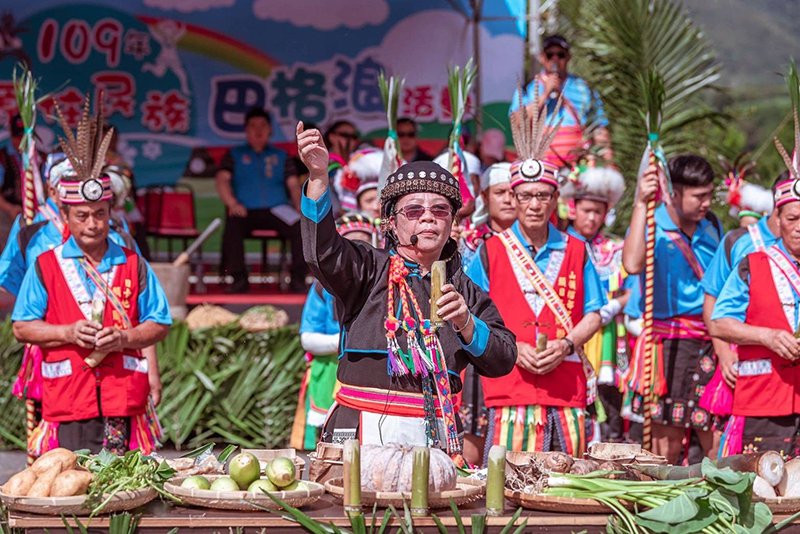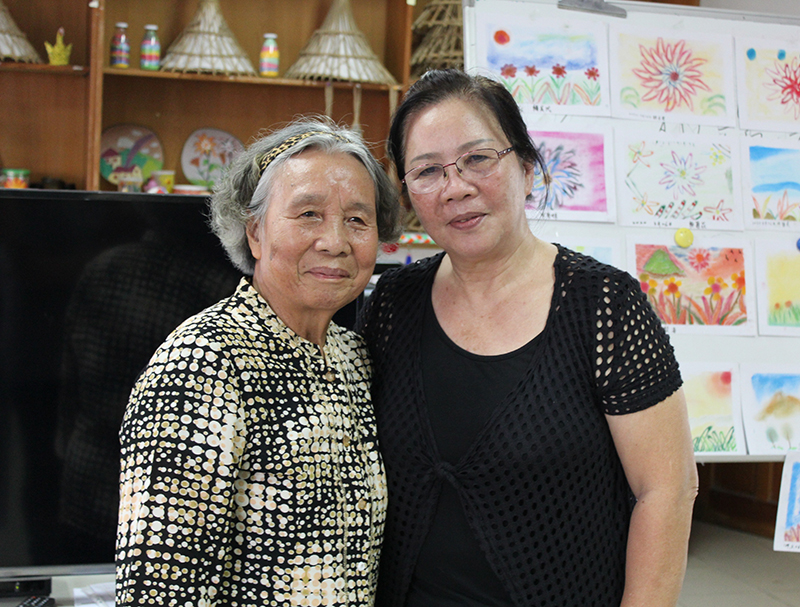 Above: Women in Parayapay Community performing a ritual lifting the taboo for the family of the deceased.
Above: Women in Parayapay Community performing a ritual lifting the taboo for the family of the deceased.

Mifukayay, funeral singing, is a tradition of the Amis funeral culture, half praying and half chanting, the singer details the deeds of the deceased and connection to the indigenous community and family. The singing describes the loss of a loved one, comforts the grieving family, and encourages people to look towards the future.
“Life on earth, my dear child, relies on the deities that protect us. Your husband has left you, you must move on and focus on your children, your family, and your clan... Stop tormenting yourself, stop reminiscing about the past, let him go...”
Nikar singing the mifukayay, ep 94: Traditional Mifukayay at Parayapay, Sound of the East Coast, Taiwan Indigenous TV
The singer’s sorrowful and suave vocal lingers in the house. Everyone sits solemnly in a circle, allowing the singing to trigger their memories, leaving many hanging their heads in tears. This is the Amis people gathering and singing mifukayay with the family of the deceased. Traditionally, the funeral ritual of the Amis people is extremely complicated. The entire process involves a series of corresponding rituals from being on the deathbed, applying makeup, being placed in the casket, being buried, all the way to the post-funeral blessing, helping the spirit pass on, ceasing the mourning, and touring of the village.
With drastic changes in lifestyle, many ceremonies and rituals are no longer complete. However, the Parayapay Community in Luye, Taitung, still maintains the traditional Amis funeral rituals, all except the mifukayay, which is gradually disappearing. Luckily, the mifukayay culture was registered in 2020 as the Taitung County Oral Tradition and Cultural Heritage, and Nikar the elder was designated as the culture preserver.

Next day of the funeral, mirakatay at the family of the deceased.
A Rare Sight with Songs
I Once Heard As a Child
“I didn’t understand what they were singing, just that they were really sad as they sang.” Growing up in the Parayapay Community, Yoing Piya once heard her mother and great-grandmother singing the mifukayay at a relative’s funeral. Elders in the family forbade her from entering the house of the deceased, but the grieved singing of everyone could still be heard from outside the house. She never again heard mifukayay in the village afterwards and the memory faded from her.
In 2015, Yoing Piya’s great-aunt passed away. After the funeral, the larger family gathered in the house of the deceased in reminisce of the deceased, and when Nikar began singing the mifykayay, Yoing Piya recalled her childhood memory, “I’ve heard this song before when I was a child!” As an indigenous language teacher, Yoing Piya bears the mission and passion for cultural inheritance. Realizing that this is a rare sight of a traditional culture, she immediately picked up the filming device close at hand and recorded the audio and visual of the entire mifukayay. This was also the first time Nikar sang mifukayay in the presence of everyone.
Nikar’s husband passed away in 2011, and whenever she is alone, she tried to sing the mifukayay elders used to sing to release the sorrow in her heart. With repeated singing day after day, she gradually got the hang of it. 4 years later, upon the death of a family member, Nikar worked up the courage to sing for the first time in front of other people, hoping to comfort their grieve with her singing.
“My great-aunt is Nikar’s aunt on her mother’s side, and they share many memories. She described from her heart the history between the deceased and her family, neighbors, friends, and the community, and the deep affections touched the hearts of many. Tears rolled down her cheek as she led the song, and family members all cried as well.” Listening again to the recording from that day, tears again welled-up in Yoing Piya’s eyes.

Blessing ritual for the Amis harvest ritual.
Pass On Our Culture,
Never Give Up Learning
However Difficult It May Be
The mifukayay sang by Nikar not only brought back Yoing Piya’s memory, but also reminded the community of the near-lost tradition. Ever since then, whenever there is a funeral in the village, people would invite Nikar to sing the mifukayay. With the aim to help others to move on from the sadness, she sang with all her might.
With her profound interest in the mifukayay culture, Yoing Piya began learning from Nikar, recording the entire process of singing, accumulating a large amount of audio-visual material, and applied to the government for mifukayay to be registered as intangible cultural heritage. Nikar is aging and she worries that no one will be able to continue singing after she passes away, therefore she encourages Yoing Piya to learn the mifukayay as well. But “it is really difficult, and more than just singing,” Yoing Piya sighs.
There are three forms of mifukayay: mifukayay, mirakatay, and Pa’olic; all led by one person but differ in the melody and singing scenario. These 3 forms combine the singing and funeral oration, half praying and half singing. The lyrics and melody have no fixed form or start and finish, the lead singer must be well-versed in the Amis language as well as familiar with the family matters of the deceased. The person must also be equipped with the ability to organize and arrange to quickly combine the content required with the melody, so as to spontaneously sing the deeds of the deceased and connection with the family members present.
Among which, mifukayay has the most vocal runs and is the most complicated; so far, only Nikar is capable of singing it. The mirakatay describes the deeds of the deceased and is sang during the touring, and the Pa’olic blesses people, help to cease the mourning, and sang during the harvest ritual. These two forms are relatively simple in melody and easier to learn, so far, Yoing Piya has grasped the technique required to sing them. With the mifukayay certified as intangible cultural heritage, Yoing Piya and the community leader plan to invite Nikar to teach their people how to sing mifukayay and pass on the valuable culture.
The 3 forms of the Amis mifukayay
Mifukayay: on the afternoon of the closing of the funeral, everyone sits in a circle inside the house of the deceased, family members and friends take turn in encouraging and consoling the family of the deceased, and the lead singer will sing mifukayay, describing the deeds of the deceased and previous interactions with family, friends, and the community.
Mirakatay: the morning after the funeral, family and friends will gather and visit the places the deceased used to frequent (such as the work shed and the vegetable garden) and call on the spirit of the deceased. It is a mourning ritual (touring) unique to the Amis people. At every location, the family of the deceased would ask, “is the deceased here?” Everyone will answer, “he/she has passed away and no longer here, please accept the fact.” Afterwards the lead singer will sing the mirakatay, describing the connection between the deceased and places visited, and inform the deceased that the funeral has been completed successfully, the remaining family members will settle their sadness and move on with their lives.
Pa’olic: there are 2 forms, blessing and ceasing the mourning for households that held funerals, and blessing for young people living and working away from home. On the last day of the harvest ritual, women would sing in blessing at every household. Those that had held funerals cannot attend the harvest ritual, therefore the women would first ask those certain households whether they need Pa’olic sang to life their taboo. If the household accepts, it means the mourning has ceased and they can attend the harvest ritual with others. At the evening event before the harvest ritual draws to an end, the lead singer will sing the Pa’olic to report to elders how the harvest ritual went and remind the younger ones due to leave again for school or work to be careful and stay healthy.
Comfort the Grief
and Look Towards the Future
“The singer of mifukayay is not the sikawasay (Amis shaman), you must be empathetic with the sadness to comfort others.” Yoing Piya says that singing is one of the ways Amis people communicate their emotions. In the past, singers are mostly family members or friends of the deceased, so they can sing from their heart to honestly express their emotions, and help the living settle their sadness and look towards the future.
The mifukayay repeatedly encourages the living to “live a good life,” demonstrating the intimate affectual relationship between people, therefore, if the singer is not familiar with the deceased, they may not want to sing for the family. “It would be disrespectful to the deceased,” explains Yoing Piya.
Every year at the Parayapay harvest ritual, Yoing Piya is most often seen holding on to Nikar as she sings the Pa’olic. Even though Nikar has slowly transferred the singing lead to Yoing Piya in recent years, Yoing Piya still thinks that “as long as Nikar can still sing, I would like her to continue leading the singing. Everyone thinks differently and has different experiences, her vocabulary is very different from mine and that is an extremely valuable treasure, also what I am trying hard to learn from her.”

Nikar (left) and Yoing Piya (right).




